Chaucer’s Medieval London Guided Walk Sun 11.30am 7th April 24 Aldgate Tube. To Book
The Decline And Fall Of Roman London Walk Sat 1.30pm 25th May 2024 Exit 2 St Pauls Underground Station. To Book
Jane Austen’s London Sat 6pm 25th May 2024 Green Park Tube (Green Park exit, by the fountain) to Book
The Peasants Revolt Anniversary Walk Thurs 6.30 13th June 2024 Aldgate Tube. To book
Chaucer’s Medieval London Guided Walk Sat 2.30pm 6th July Aldgate Tube. To Book
Myths, Legends, Archaeology and the Origins of London Sat 6pm July 6th 24 Tower Hill Underground To book
Roman London – A Literary & Archaeological Walk Sun 11.30 am 4th August 2024 Monument Underground Station To book
1066 and All That Walk Sat 2.30pm 9th Nov 24 Blackfriars Underground Station To book
For a complete list of my walks for London Walks in 2024 look here:
Archive of Events and Walks (2024)
I keep an archive of the walks I have done each year. This is the first entry for 2024.
My new year’s resolutions for my walks are:
- Make the Virtual tours shorter.
- Try some new technology to make the virtual tours more like a walk.
- Begin publishing them.
I should note that 1 and 3 have long been on my list of desired improvements.
Ring in the New Year Virtual Walk
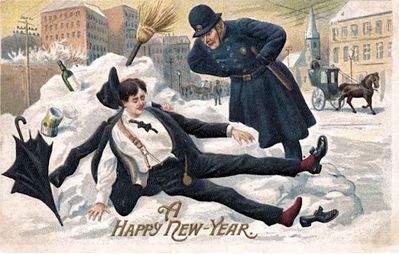
Monday 1st January 2024 7.00pm
On this Virtual Walk we look at how London has celebrated the New Year over the past 2000 years.
The New Year has been a time of review, renewal and anticipation
of the future from time immemorial. The Ancient Britons saw the Solstice as a symbol of a promise of renewal as the Sun was reborn. As the weather turns to bleak mid winter, a festival or reflection and renewal cheers everyone up. This idea of renewal was followed by the Romans, and presided over by a two headed God called Janus who looked both backwards and forwards. Dickens Christmas Carol was based on redemption and his second great Christmas Book ‘The Chimes’ on the renewal that the New Year encouraged.
We look at London’s past to see where and how the New Year was celebrated. We also explore the different New Years we use and their associated Calendars – the Pagan year, the Christian year, the Roman year, the Jewish year, the Financial year, the Academic year and we reveal how these began. We look at folk traditions, Medieval Christmas Festivals, Boy Bishops, Distaff Sunday and Plough Monday, and other Winter Festival and New Year London tradition and folklore.
At the end we use ancient methods to divine what is in store for us in 2024
ROMAN LONDON – A LITERARY & ARCHAEOLOGICAL WALK
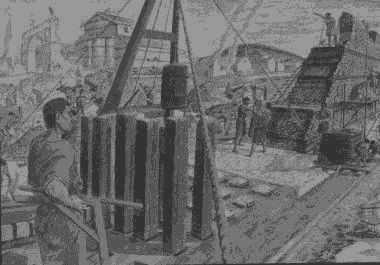
Sunday 21st Jan & 3rd March 2023 11.30 am Monument Underground Station
Our Guides will be Publius Ovidius Naso and Marcus Valerius Martialis who will be helped by Kevin Flude, former Museum of London Archaeologist, Museum Curator and Lecturer.
To book
We disembark at the Roman Waterfront by the Roman Bridge, and then explore the lives of the citizens as we walk up to the site of the Roman Town Hall, and discuss Roman politics. We proceed through the streets of Roman London, with its vivid and cosmopolitan street life via the Temple of Mithras to finish with Bread and Circus at the Roman Amphitheatre.
REVIEWS
“Kevin, I just wanted to drop you a quick email to thank you ever so much for your archaeological tours of London! I am so thrilled to have stumbled upon your tours! I look forward to them more than you can imagine! They’re the best 2 hours of my week! 🙂 Best, Sue
Jane Austen’s London Sunday Jan 21st 2.30 pm Green Park underground station,
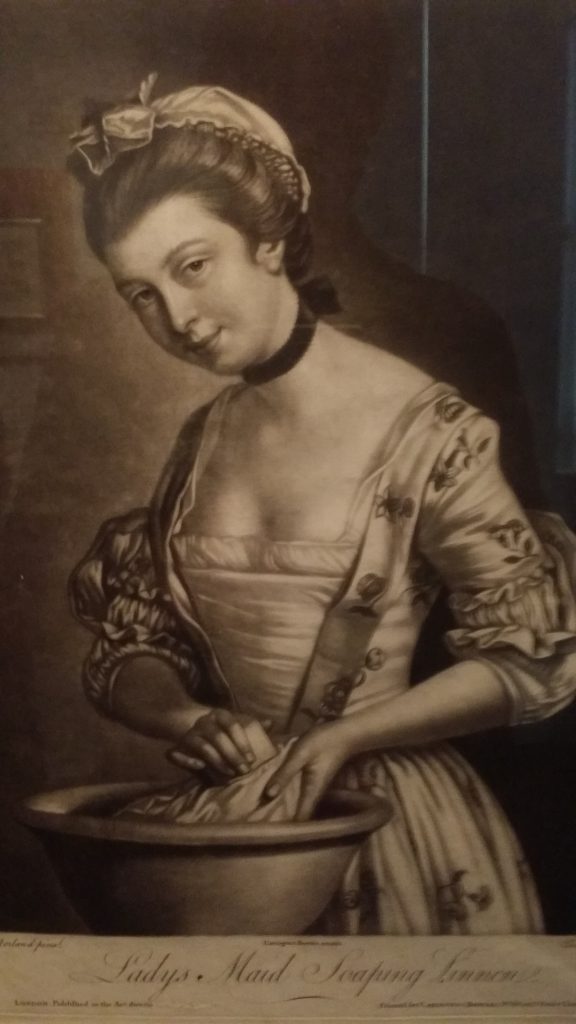
An exploration of Mayfair, the centre of the London section of Sense & Sensibility and where Jane came to visit her brother
“It is a truth universally acknowledged, that a Jane Austen devotee in possession of the good fortune of a couple of free hours today must be in want of this walk.”
People associate Jane Austen and her characters with a rural setting. But London is central to both Jane Austen’s real life and her literary life. So, this tour will explore Jane’s connections with London and give the background to Sense and Sensibility, a good part of which is based in this very area. We begin with the place Jane’s coach would arrive from Hampshire, and then walk the streets haunted by Willougby; past shops visited by the Palmers, the Ferrars; visit the location of Jane Austen’s brother’s bank and see the publisher of Jane’s Books. The area around Old Bond Street was the home of the Regency elite and many buildings and a surprising number of the shops remain as they were in Jane Austen’s day.
This is a London Walk Guided Walk lead by Kevin Flude
Myths, Legends, Archaeology and the Origins of London
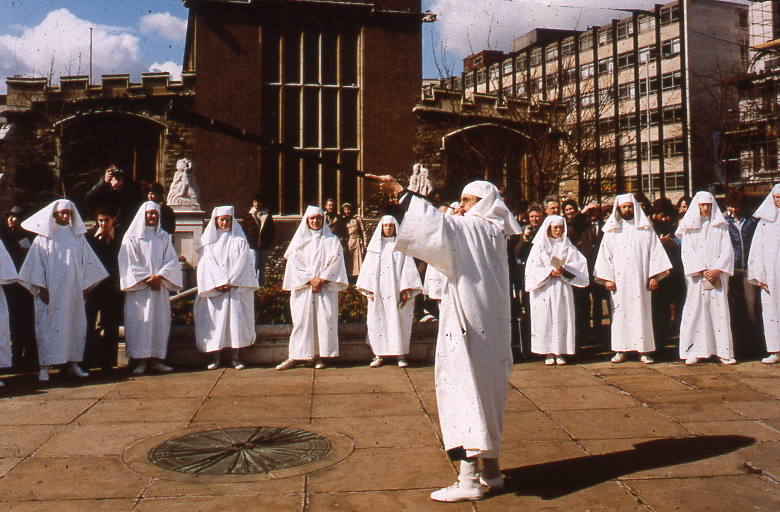
Sunday 4th February & Saturday 23 March 2024 11.30pm Tower Hill Underground
The walk tells the stories of our changing ideas about the origins of London during the Prehistoric, Roman and Saxon periods.
The walk is led by Kevin Flude, a former archaeologist at the Museum of London, who has an interest both in myths, legends and London’s Archaeology.
The walk will tell the story of the legendary origins of London which record that it was founded in the Bronze Age by an exiled Trojan and was called New Troy, which became corrupted to Trinovantum. This name was recorded in the words of Julius Caesar; and, then, according to Legend, the town was renamed after King Ludd and called Lud’s Dun. Antiquarians and Archaeologists have taken centuries to demolish this idea, and became convinced London was founded by the Romans. Recently, dramatic evidence of a Bronze Age presence in London was found.
When the Roman system broke down in 410 AD, historical records were almost non-existent, until the Venerable Bede recorded the building of St Pauls Cathedral in 604 AD. The two hundred year gap, has another rich selection of legends. which the paucity of archaeological remains struggles to debunk.
The walk will explore these stories and compare the myths and legends with Archaeological discoveries.
The route starts at Tower Hill, then down to the River at Billingsgate, London Bridge, and into the centre of Roman London
Tudor London – The City of Wolf Hall
Sunday 4th February 2024 2.15pm Barbican Underground Station
Tudor London – The City of Wolf Hall Virtual Tour Sunday 4th February 2024 7.30 pm To book
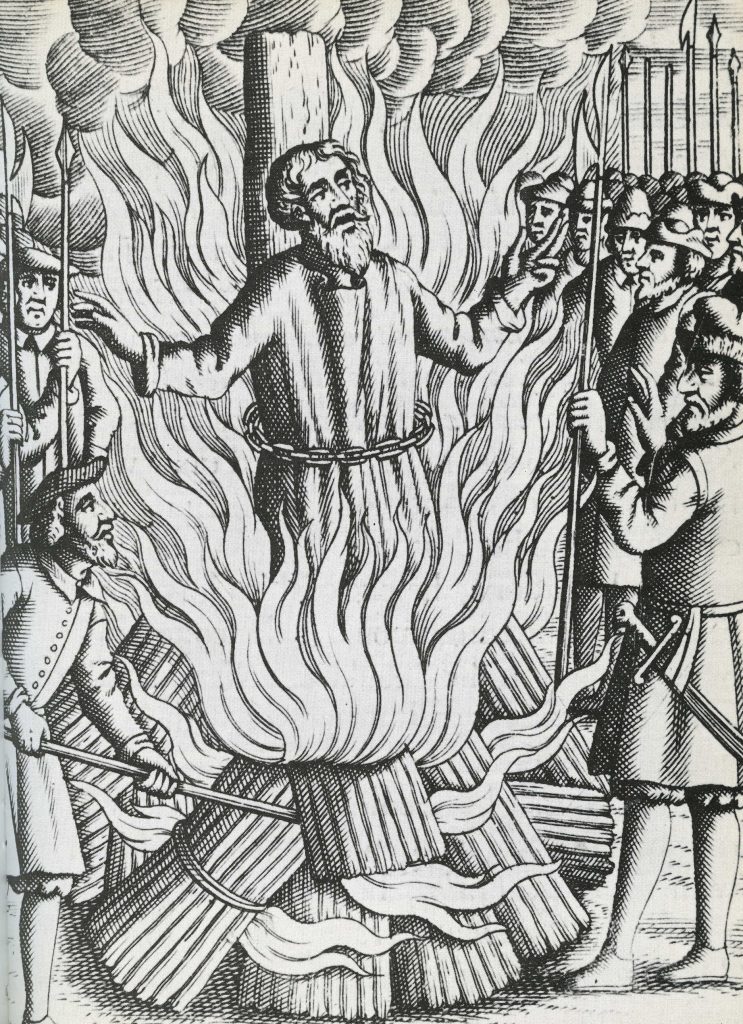
The Walk creates a portrait of London in the early 16th Century, with particular emphasis on the life and times of Thomas Cromwell and Thomas More during the Anne Boleyn years.
More and Cromwell had much in common, both lawyers, commoners, who rose to be Lord Chancellor to Henry VIII, and ended their careers on the block at Tower Hill.
The walk starts with an exploration of Smithfield – site of the stake where heretics were burnt alive and of St Bartholomew’s Monastery – given to Richard Rich after his decisive role in the downfall of Thomas More. We continue to St Paul where Martin Luther’s books were burnt, and later, where Puritans preached against dancing round the Maypole.
We walk along the main markets streets of London, to Thomas More’s birthplace, and to the site of More’s and Cromwell’s townhouses before, if time allows, finishing at the site of the Scaffold where More and Cromwell met their ends, overlooking where Anne Boleyn was incarcerated in the Tower of London
The Leap Year Pub Walk Thurs 6pm 29 February 2024 Tower Hill Underground

Thurs, 29 February 2024, 6pm Tower Hill Underground
We explore London, the Leap Year and 29th February through history
A strange amazing day – and walk – that comes only once every four years. For the rest of the time it does not “exist.” A day – and walk – of temporal tune-up. A day – and walk – of unlocked potential. A day – and a walk – of unlocked London.
As the Sun, Moon and Seasons have different cycles and don’t fit into a set number of days, Londoners have had to cope with fixes to their Calendars to align the Cosmos with everyday life. As we walk through the streets of the ancient City of London, we explore how Londoners organised and celebrated their year throughout history
One of the most popular forms of publication in London was the Almanac. It was full of seasonal advice, of prophecy, traditional wisdom, and important events past and future. We will look at Almanacs and Diaries to find how Londoners spent their Leap Year.
We start with the Romans at the City Wall, near the Tower of London, and walk through history until we reach a historic pub to celebrate the New Year.
The Leap Year Almanac of the Past Pub Walk is led by Kevin Flude, a lecturer, curator and former archaeologist at the Museum of London. Join him to explore London’s History through its celebrations, festivals, calendars and almanacs.
This is a London Walks Guided Walk.
Roman London – A Literary & Archaeological Walk Sun 11.30 am 3rd March 2024 Monument Underground Station To book
Jane Austen’s London Sun 2.30 pm 3rd March 2024 Green Park Underground station (Green Park Exit. Fountain in Green Park), To book
Myths, Legends, Archaeology and the Origins of London Sunday 11.30am 23rd March 2024 Tower Hill Underground
London. 1066 and All That Walk
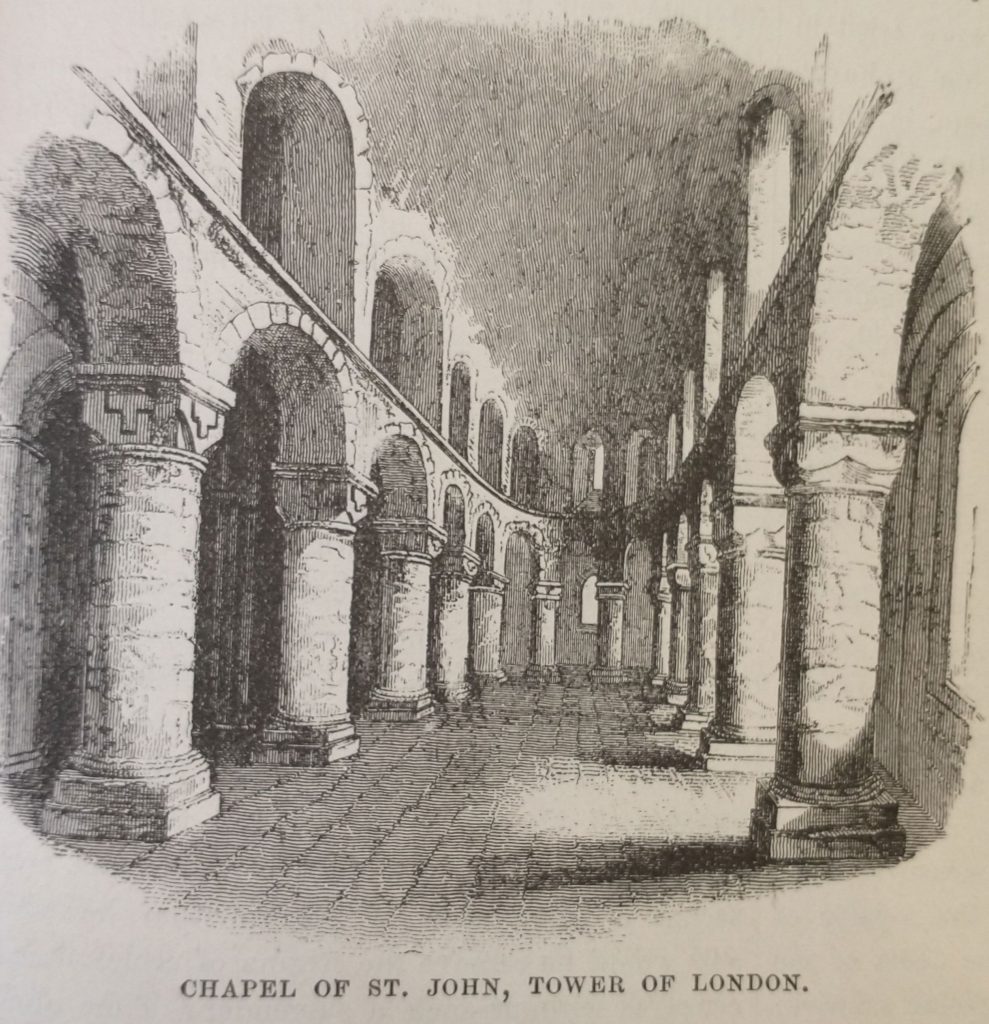
Sunday 2.30pm 23rd March 2024 Blackfriars Underground Station
The Archaeological Walk that explores the City of London at the end of the Saxon period and at the beginning of the Norman.
The Norman Conquest of 1066 defines Britain in a way unmatched by any other event. And on this walk we explore the London that William conquered and how he changed England for all time.
London was England’s most important City, but not yet the capital. It was crucial to William in his attempt to conquer the realm. But his army could not fight their way across the heavily defended London Bridge after the defeat of the English King, Harold, at the Battle of Hastings.
The future of England was in the balance as he ravaged the country seeking a way across the river and to persuade the English that resistance was hopeless.
Once across the river, the English leaders sued for peace, and William was crowned at the newly built Westminster Abbey. The English hoped for a strong King who would rule with the people. But William began by building Castles to oppress the Citizens, and soon swept aside the English Aristocracy and establishment and replaced them with the Conquerors.
This was a death blow to Anglo-Saxon culture, but the City made an accommodation with the new regime and the first Lord Mayor of London was an Englishman.
So, on the walk we explore the Late Saxon City of London, and how it changed in the last 11th and 12th Centuries.
Walk is by Kevin Flude, former Archaeologist at the Museum of London
Kevin
To Book:
New Year’s Day – Ring in the New Year Virtual Tour. Today at 7pm.

Tonight, I am giving my annual Ring in the New Year Walk for London Walks.
To book, click the link below
https://www.eventbrite.co.uk/e/ring-in-the-new-year-virtual-walk-tickets-756382860497
New Year’s Eve—The White Heather Club and Hootenanny December 31st

On the seventh day of Christmas
My true love sent to me:
7 Swans a Swimming; 6 Geese a Laying;
5 Golden Rings;
4 Calling Birds; 3 French Hens; 2 Turtle Doves
and a Partridge in a Pear Tree
First an admission, there is a lot of confusion out there as to which is the First day of Christmas. According to my muse, Charles Kightly, the first day of Christmas is Boxing Day, the 26th of December. This makes Twelfth Night January 6th, which is Epiphany – when the three wise men rocked up with their fabulous presents. But that is a Christian day of importance, and most other authorities begin the counting on Christmas Day. So, Twelfth Night is Epiphany Eve, i.e. January 5th. Have a look at Notes&Queries for different viewpoints. One suggestion was that the Church had to accept that the Twelve Days of Christmas were taken up with pagan activities and allowed it to go on until the night before Epiphany. I have gone back and rearranged my days of Christmas accordingly and am I going to take my Christmas decorations down before going to bed on the 5th January. Twelfth Night.
New Year’s Eve
This is a day of preparation, and perhaps of anxiety. Have we got an invitation anywhere tonight? Is anyone going to come to our party? Can I take another blow out feast, a belly full of alcohol and a very late night? For years in my life, New Year’s Eve was spent with my parents watching some inexplicable variety show hosted in Scotland. Google has helped me remember that it was the ‘White Heather Club’ hosted by Andy Stewart. Up to 10 million people watched this between 1960 and 1968. I never understood the pleasure of it, and it seemed a symbol of an old-fashioned world that was passing and irrelevant.
More recently, if not spent at a party, New Year’s Eve is spent with Jools’ Annual Hootenanny, which is a music show masquerading as a live New Year’s Eve party. It features really excellent bands and singers. It is, however, recorded earlier in December (15th, 20th are dates I have seen) and hence a New Year’s fake. Here is a 2007 except starring Madness’s ‘House of Fun’. The fun of this is to spot the stars grooving along to the music.
New Year’s Day needs a lot of preparation. Folklore suggests that this should include finishing off any unfinished work or projects, as a task carried forward is ill-omened. Your accounts for the year should be reconciled, and as Charles Dickens suggests in the Chimes, your moral account with the world should also be addressed so that you can come into the New Year with a clean slate, good conscience and plans for a better new year. And don’t we all need that for 2023!
To see the rest of this post, follow this link:
St John’s Day. Forecasting the Weather. December 27th

On the third day of Christmas
My true love sent to me:
3 French Hens
2 Turtle Doves
And a Partridge in a Pear Tree
Folklore is full of risible methods of forecasting the future and Gervase Markham’s ‘The English Husbandman of 1635 is no exception. He says:
‘What weather shall be on the sixth and twentieth day of December, the like weather will be all the month of January.’
Then and so on for the 12 days of Christmas. So today’s weather will be the weather ‘the following February’ and so on.
According to Gervase, the weather in January and February is going to be warm, and with storms in parts of Britain such as Manchester.
This is St, John’s Day, he who was loved by Jesus and wrote the Gospel making him the patron saint of booksellers, publishers, printers and writers. Lecterns in the Church of England are normally shaped as an Eagle as this is the symbol of St John, as a writer of grace and power, and a messenger of Authority from God.
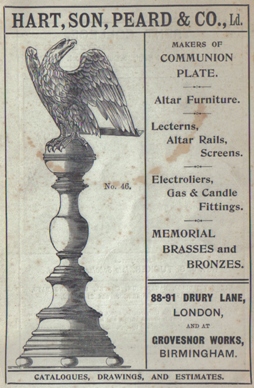
Remember, on 1st January 7.30 I am doing my annual ‘Ring in the New Year’ virtual walk where I look at all things new year. To see more details click here:
First Published in December 2021, revised and republished in December 2023
Drink & Be Merry at a Georgian Christmas December 23rd
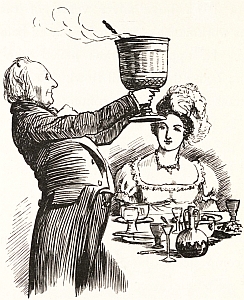
The drinks of choice were: port. Then brandy, claret, punch, rum, porter. So says my source Henry Jeffreys in his book ‘Empire of Booze’ and in this Guardian article:
Claret, probably, originally outsold port. But the wars against France and the difficulty of importing French wine, saw a transfer to wines from our ‘oldest ally’ Portugal. But the travel distance was longer, so the wine was fortified to help preserve it better. Hence, the British addiction to port. Sherry was also popular for similar reasons, being a fortified white wine. Shakespeare calls it ‘sack’ and sometimes ‘Canary’. (Toby Belch ‘says thou lack’st a cup of canary ‘ in ‘Twelfth Night’, which is a Christmas play.)
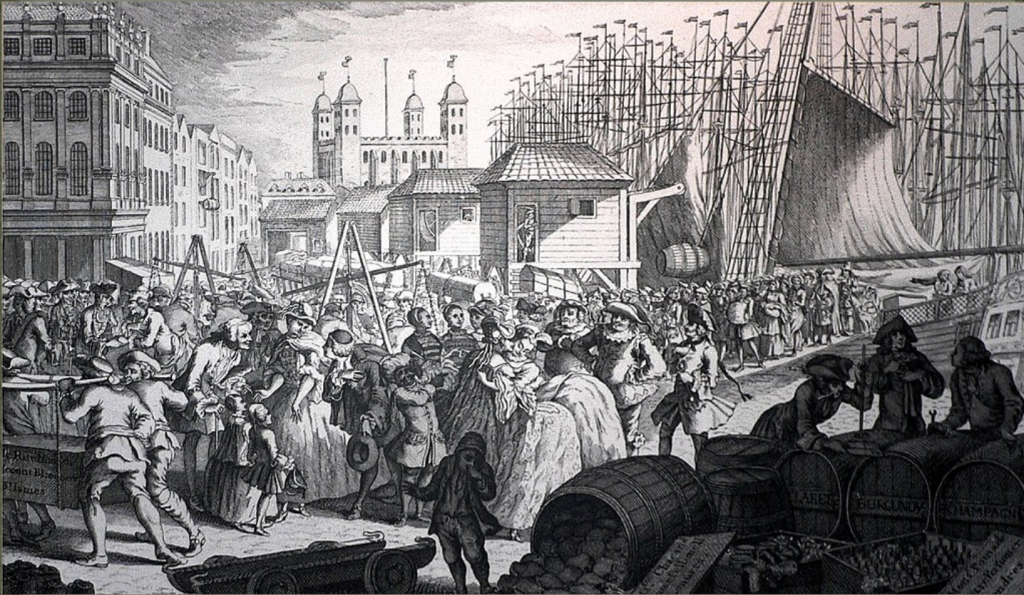
Consumption was prodigious. Samuel Johnson said, ‘All the decent people in Lichfield (where Johnson came from) got drunk every night and were not the worst thought of’. The Prime Minister. William Pitt the Younger said, ‘I have drunk three bottles of port without being the worst for it. University College has witnessed this.’ He is referring to his college at Oxford University, and so he might be considered to be another of our Prime Ministers who have disgraced themselves at Oxbridge only to rise to rule the unfortunate British. However, in those days, Port was sold in pint measures (45cl) and was 16%, while now it is 20% and sold in 75cl bottles.
Even so, three bottles is still a lot and a drunken population would have not only increased the death rate but also increased violence and abuse. Gout was one result of too much drinking and a rich diet.
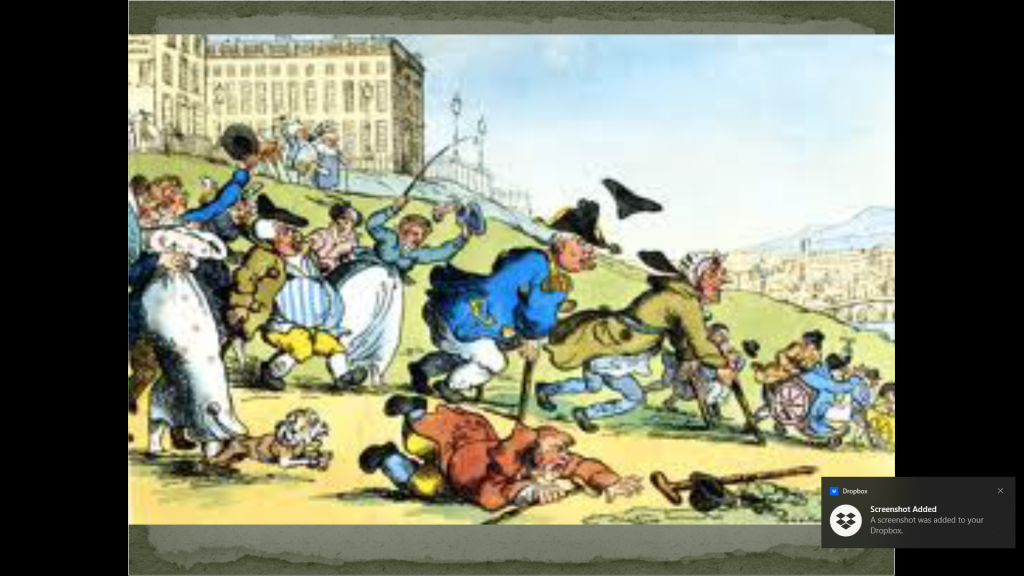
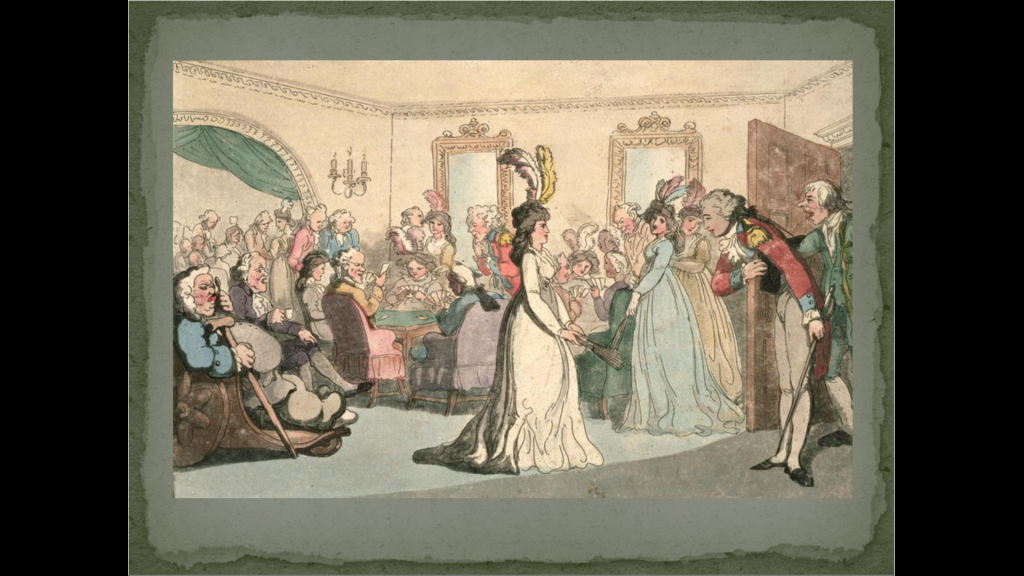
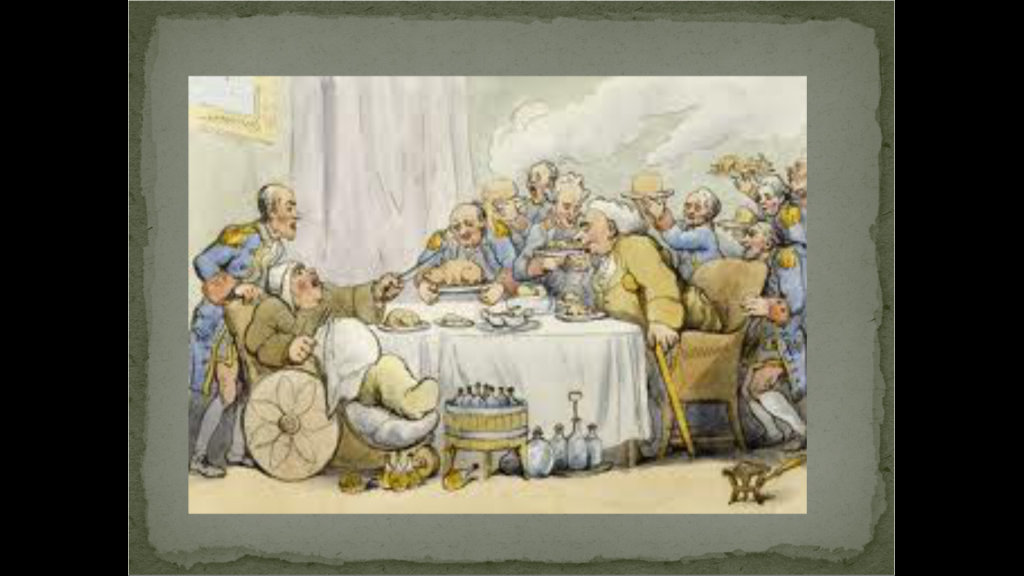
However, this is Christmas so let’s end on a high note, so here are a couple of recipes!
To make ye best punch
“Put 1½ a pound of sugar in a quart of water, stir it well yn put in a pint of Brandy, a quarter of a pint of Lime Juice, & a nutmeg grated, yn put in yr tosts or Biskets well toasted.”
Katherine Windham’s Boke of Housekeeping, 1707
And Gin? While by the 1770s the fear of the effects of cheap gin had ceased to be hot news, and after no less that eight Gin Acts of Parliament to control misuse, its cheapness was not such a threat to an ordered society. Booths and Gordon’s Gins were established in London during this period.
There seems to be a shortage of Gin punch recipes for the 18th Century, but by the end of that century this recipe survives from London’s Garrick Club
– half a pint of gin, lemon peel, lemon juice, sugar, maraschino, a pint and a quarter of water and two bottles of iced soda water.
You would not need many of these to become quite relaxed quite quickly!
First Published in 2022 and revised December 2023
Midwinter Links: Edo in Winter & Society & Santa Claus’ Elitist Origins
Here are some fascinating links with a seasonal theme, and at the end of the post the December posts I have reviewed, revised and reposted. And to remind you, I have a Winter Solstice Virtual Tour on Friday, and a Jane Austen Virtual Tour taking place on Saturday.. Follow the links on the www.chr.org.uk to find out more or book.
The wintery landscapes of Utagawa Hiroshige | with Alfred Haft |
This is a short video of an event held for British Museum members. It’s on YouTube, so it should be available for non-members. It shows, with some animation, beautiful snowy landscapes by the great Hiroshige. It is 12 minutes long.
Santa Claus’ Elitist Origins
I came across Ben Tumin’s conversation with Professor Stephen Nissenbaum on Santa Claus’ Elitist Origins in Tumin’s Skipped History Substack posts. Nissebnaum wrote a highly rated book called the ‘Battle for Christmas’, which pointed out that, before the 19th Century, Christmas was largely outdoors, and a riotous time of debauchery, gluttony, and drunkenness. The ruling classes managed in the 19th Century to change this for a quieter, indoor, family-based experience. Well worth a listen.
Almanac of the Past December Posts:
Here are the posts I have reviewed and republished since the last email for subscribers:
Christmas with Jane Austen Walk, Tour & Podcast
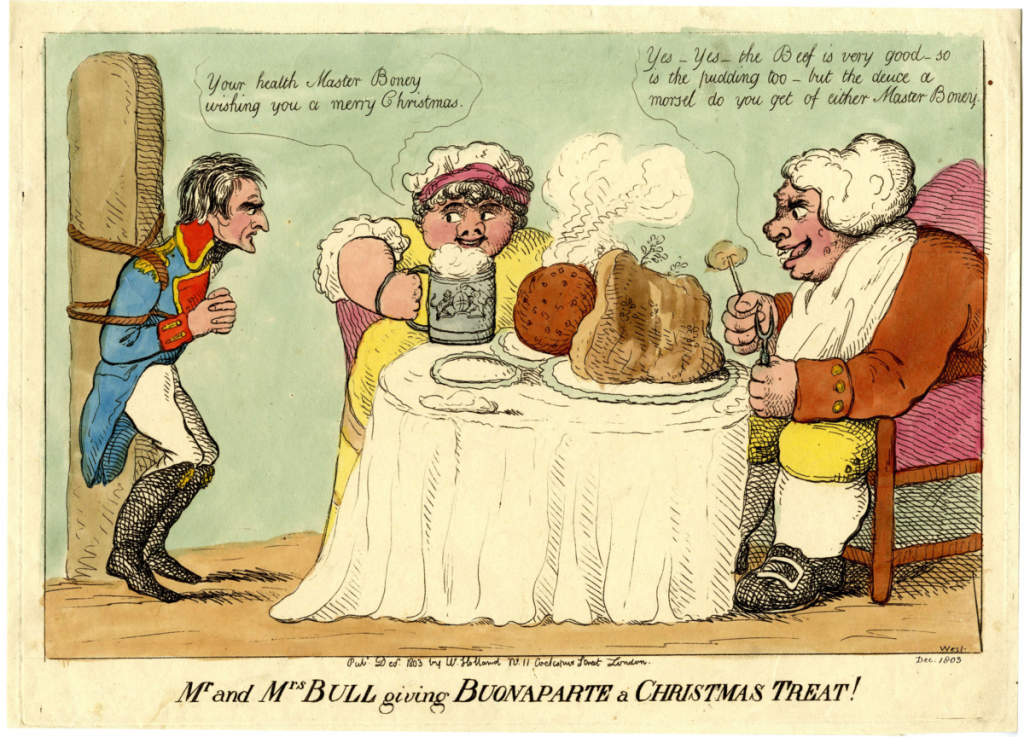
Saturday 23rd December. Walk at 2.30pm, Virtual Tour at 7.30pm
We look at London Austen’s London and at how Jane Austen spent Christmas and at Georgian Christmas traditions and amusements.
Here is a short podcast about the walk and Regency Christmas traditions.
“It is a truth universally acknowledged, that a Jane Austen devotee in possession of the good fortune of a couple of free hours must be in want of this virtual walk.”
This is a special walk, which looks at the traditions of Christmas during the Regency period and how Jane Austen might have celebrated it. It will give some background to Jane Austen’s life and her knowledge of London. We used her novels and her letters to find out what she might have done at Christmas, but also at how Christmas was kept in this period, and the range of ‘Curiosities, Amusements, Exhibitions, Public Establishments, and Remarkable Objects in and near London available to enjoy.
This is a London Walks Guided Walk by Kevin Flude, Museum Curator and Lecturer.
Review: ‘Thanks, again, Kevin. These talks are magnificent!’
You might like to have a look at my Almanac of the Past. I have revised and updated the following posts:
June 9t St Columba’s (St Colmcille’s) Day
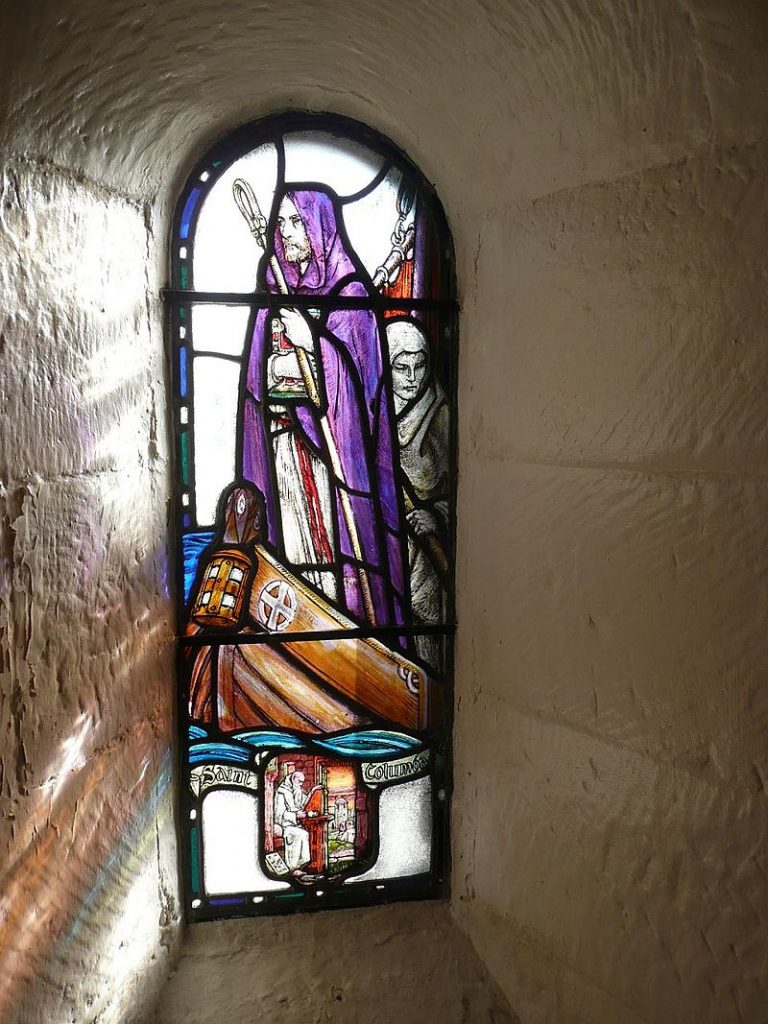
St Columba, or Colmcille is one of the most important saints for the early transmission of Christianity. He was born in 521 and said to be a descendent of the possibly legendary Irish King Niall of the Nine Hostages. (The Hostages were a token of Niall’s power as they came from the five provinces of Ireland, which are Ulster, Connacht, Leinster, Munster, and Meath. The other four represented Scotland, the Saxons, the Britons, and the Franks). Columba was sent, at an early, age to be brought up as a Monk and went on to set up Monasteries in Ireland at Derry and Durrow.
In 563, he left Ireland, possibly because he got involved in a dispute that lead to loss of life. He went into exile to Scotland and set up the famous Monastery on the island of Iona, Inner Hebrides, off the coast of what would one day be called Scotland. At the time, it was under the control of the Kingdom of Dál Riata, which was nominally Christian and controlled parts of Ulster and Western Scotland. From Iona, Columba led the conversion of the Picts to Christianity, which helped towards the unification of the Gaels, the Picts and the Britons, eventually into the Kingdom of Alba which became Scotland. Early Scottish Kings such as Macbeth (Mac Bethad mac Findlaích) were buried here.
Much of the events of this part of Columba’s life are legendary as recorded by St. Adamnan in The Life of Saint Columba written in the 7th Century. One notable story is that he came across a group of Pagan Picts who were mourning a child killed by a monster in the River Ness. St Columba revived the child. He then sent one of the Brothers to swim across the Loch to fetch a boat. The “water beast” pursued the Monk and was about to attack him when St Columba told the monster to stop, and so it did, retreating to the depths of Loch Ness. Thus founding the legend of the Loch Ness monster.
St Columba died in 597AD. Iona continued to prosper and in, 634AD sent St Aidan from Iona to found the Monastery at Lindisfarne. This was instrumental in the conversion of the Kingdom of Northumbria. This tradition of evangelism took hold in the British Isles, and it was from here that much of the German-speaking world was converted to Christianity.
This is St Columba’s legacy.
There is a developing understanding among scholars that this Irish inspired form of Christianity took a leading role in ritual, art, scholarship in the Roman Catholic world at this time. Just stop and think about that sentence for a moment. The north-western extreme of the Islands off the coast of Europe took a leading role in the development of Western Christianity. This was highlighted in a recent exhibition of Anglo-Saxon art at the British Library.
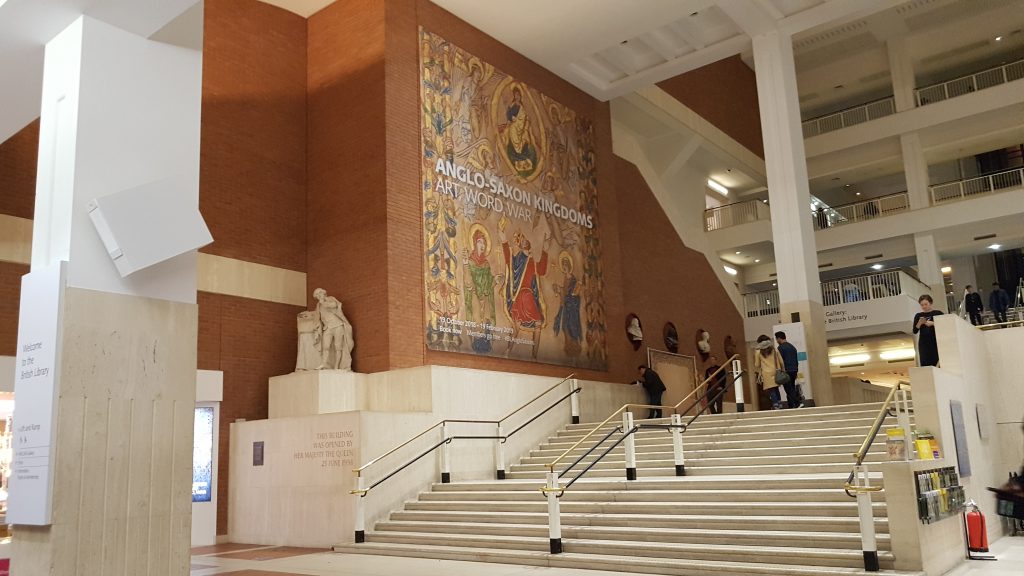
A look at the Lindisfarne Gospel and the Book of Kells showcases the amazing art of this period. For a real treat, look through this scrollable virtual copy of the Lindisfarne Gospel. It has been missing from the displays of the British Museum for a couple of years, and was on display in Northumberland in 2022. I’m not sure whether it is yet back on display at the British Museum. I hope so, but the scrollable version almost compensates for its absence. You can see the Book of Kells at Trinity College, Dublin or look at their online offering here: Not quite as joyous an experience as the online Lindisfarne but beautiful enough.
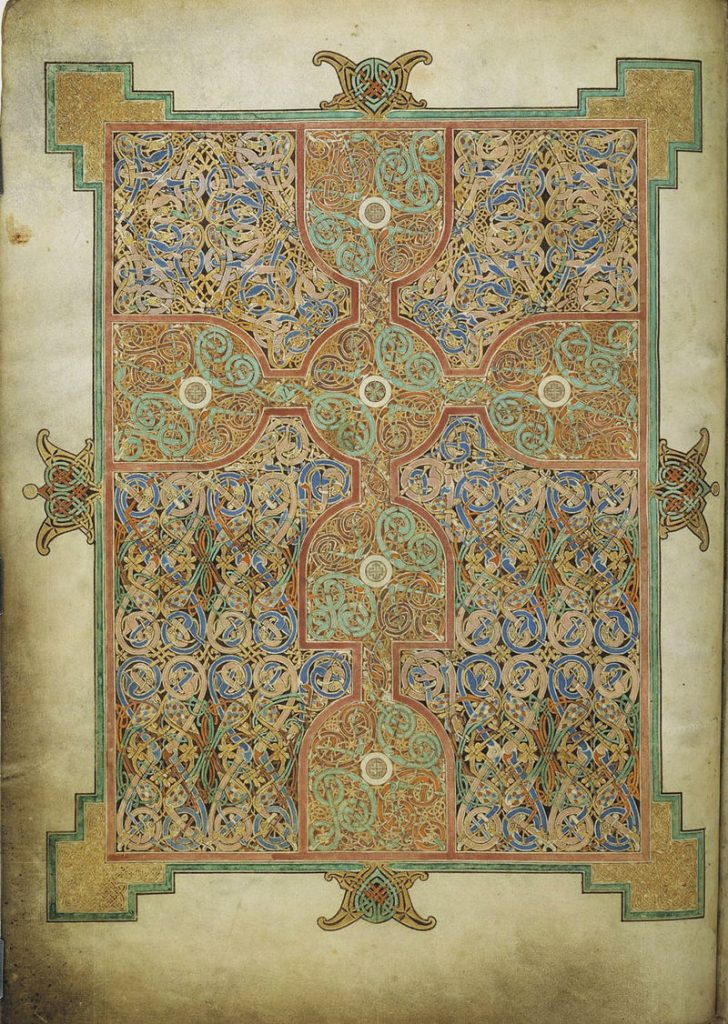
Lindisfarne evangeliarium, tapijtbladzijde op f26v, Matteüsevangelie
Here is a virtual tour of Iona
Here is a 360-degree panoramic photo tour of Lindisfarne Abbey
Digital Heritage. Town Exploration. Virtual Amsterdam
You may have been following my ramblings on my attempts to work out Amsterdam’s history from maps and tramping the streets. But you might want to find out more about the History of Amsterdam from your armchair. So, this is my exploration of virtual Amsterdam. But bear in mind the ideas here can be used in any town exploration.
But if you have only a little time, here are my best tips for exploring Amsterdam online.
First, below is a very good 15 minute introduction to Amsterdam history on YouTube.
Try this Google Earth satellite view of Amsterdam and have fun exploring! Then put your feet up and explore the Van Gogh collection in all its excellent online glory.
But if you have a little more time, lets look at the options as to how the Internet can help you discover Amsterdam.
Online Encyclopedias
Wikipedia – https://en.wikipedia.org/wiki/Amsterdam
Encyclopedia Britannica | Britannica – https://www.britannica.com/place/Amsterdam
I quite often edit Wikipedia pages when I come across entries which are out of date or wrong. The quality of information can be variable but mostly its good. And reading the Amsterdam Page, as long as you are prepared to follow up some of the hypertext links, such as to the ‘Canals of Amsterdam’ or the ‘Defence Line of Amsterdam’ you can get a good idea of the history. But Wikipedia, however great for humanity, is none-the-less aspiring to be an encyclopedia, and not either literature, travel-writing, non-fiction nor entertainment. It is certainly not a virtual tour, and it takes quite a lot of timeto get a good overview of the City and it is not really something I ever do for ‘enjoyment’.
Encyclopedia Britannica has been published exclusively online since 2016 and it is a better read than Wikipedia, less rambling and more to the point. Definitely a better starting point, but still a long read, and, again, something I can’t remember reading with pleasure.
YouTube
There are a number of video lectures/talks/tours on YouTube for free and I will just mention a few – please let me know if you find anything else interesting and I will add it here.
I’ve already linked to the 15 minute ‘A Quick History of Amsterdam (That Dam Guide), which is well put together and gives a good summary. Not enough about the walls in my opinion, and probably a little too much about the major drivers of historical change and not enough about the specific details of what made Amsterdam the town. That is probably asking too much for a 15 minute introduction. And, in effect, this guide is an advert for ‘That Dam Guide’ and the author’s guided virtual tours. He does live streamed 1 hour Amsterdam Tours (none on in March) Very good production values too.
Searching for ‘Amsterdam Virtual Tour’ brings me to the: The Amsterdam Drone Tour which gives a largely drone-eye view of Amsterdam, with slightly annoying music and not enough captions to really feel you are getting to know streets, areas and districts, but it does give an interesting ‘overview’. It is 9 minutes long.
A Free Virtual Tours Amsterdam is an interesting intro to Amsterdam in two 5 minute videos. It does give you some more of, what I would call, ‘structural’ analysis of the history and development of Holland/Amsterdam. It is, to an extent, complimentary to ‘That Dam Guide’. I should not be mentioning it as the ‘Free Walks’ groups are deadly rivals to ‘London Walks’, who I do my walks for. We have a fixed fee for a professional guide, while the Free Walks say they are free but put a lot of pressure on to get customers to pay up a reasonable amount (or so we think!).
Another ‘Tips based’ guide on YouTube is Tim, who gives a 20 minute free walking tour. This one is more of a real virtual walk, as it is a filmed guided walk, with all its imperfections. But, very good in terms of authenticity.
Google Earth
This uses the Google Earth satellite view of Amsterdam, with pins marking many, but by no means all, places of interest. Each place has a little information, and often, a link to Wikipedia. Clicking on the ‘more information’ tab brings up further, and sometimes an extensive number of pictures. There is also a paper aeroplane tab, and this brings up a virtual fly-past which is fun. I was looking for a tab for the Waag, which is one of the remaining gates of old Amsterdam, but I cannot find a tab for it. Nor a search button, which hinders the usefulness of the system. But it is definitely fun!
I have just gone back to Google Earth, found the search icon on the left of the screen, overflown my house, and then searched for the Waag, which I found and here it is! Follow the link to do the fly-past.
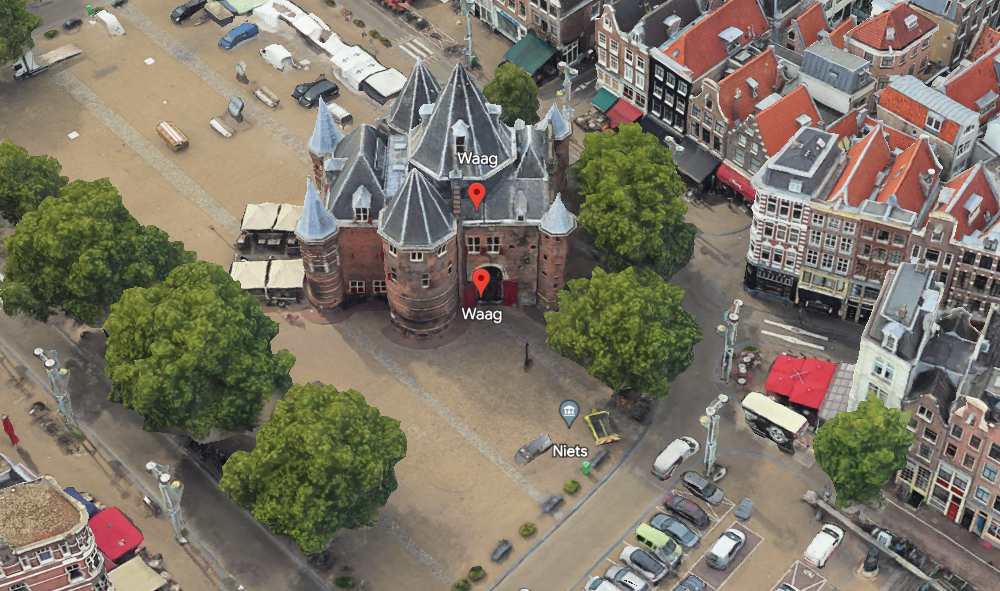
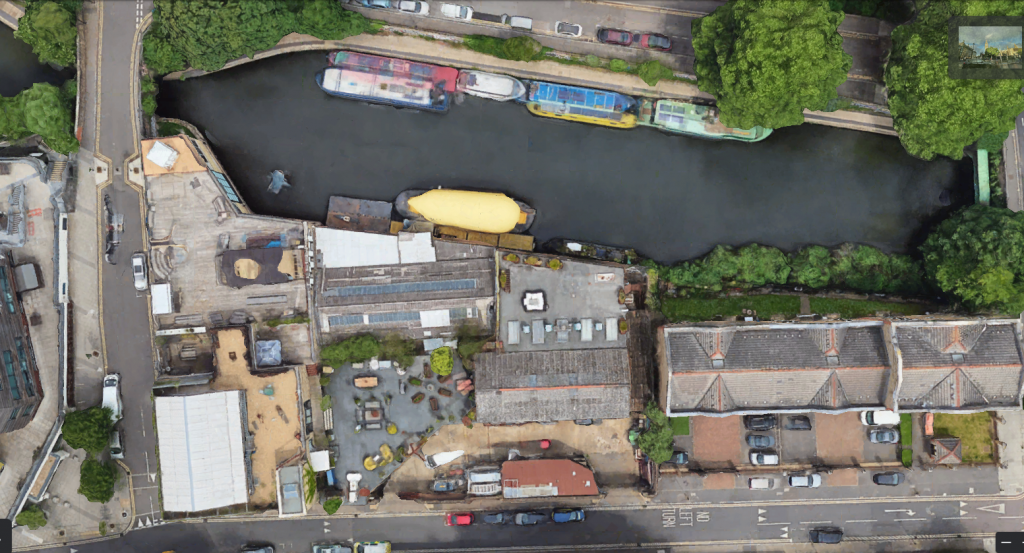
I would definitely use this to explore, and, if I were to be giving a guided tour of Amsterdam I would, indeed, use it in advance to consolidate my knowledge. It has the advantage that it brings to your attention things you would otherwise not know about, and gives a really clear idea of what the place is and what its environment looks like. For example it brought to my attention the houseboat museum, which is now on my must-see bucket list, previously unknown to me.
By the way, I found the Google Earth tour on this blog: www.asthebirdfliesblog.com which has other interesting tips for exploring virtual Amsterdam.
Guided Walks Apps
I thought these didn’t really count as they are designed to give a smart-phone based on location walking tour and not an armchair guide. GPSmycity.com is linked to GPS and the user can either access other people’s guided walks, or create their own. I tried it out in Stratford-on-Avon and found it remarkably easy to do. You find the places you want on the tour, and the app ‘sucks in’ the data and pictures from Wikipedia. So within a few minutes you have, a credible, guided tour and a GPS route around the City. In fact, I found it most useful just for creating my own walking routes – much easier than Google, or CityMapper, Just put in the stops and soon your SmartPhone will be dictating your route to you!
But you don’t have to access it via an app, in fact, if you are not going to Amsterdam, its better to visit the web site, and you can go to this link gpsmycity.com, scroll down and you will see a map, and the text for all the stops on the tour. Quite a good introduction, although not inspired. (Its possible you might need to login but I’m not sure as I do have a login.)
Another example is izi-travel, but this provides free and paid for audio guides. Again designed for a smart-phone app to guide around the location, but it can also be accessed on a computer at home. So here is the link to the Amsterdam tour – there are several to choose from.
I would definitely use gpsmycity on tour – I didn’t because I dropped my phone in the oily bilge of my boat, and it went insane for about 2 hours, and reset a lot of my settings, and deleted a few of my apps, including gpsmycity, before deciding to stage a recovery. Izi-travel I have had loaded for several years, and never used, but now listening to it I might have used it like a radio show to introduce me to Amsterdam. I’m also wondering about making my very many guided walks into virtual guided walks on apps like this.
Museum On Line Tours
The Amsterdam Museum should be the museum I would be pointing to for a great on line tour about Amsterdam’s History but it has a temporary Web Site while it works on opening a new Museum. The web has interesting stuff on it, and has the collection online, but nothing that pulls it together like an exhibition, or really gives you much of an introduction to the history of Amsterdam which is very disappointing.
The Van Gogh Museum, by contrast, has an excellent online collection which can be seen, as if a virtual exhibition. But this is much easier for an art museum than a history museum, for two main reasons: the art works are more immediately visually appealing that many objects in Museum Collections which often require context to understand; and art collections are much smaller than history museum collections and so easier to see as a ‘tour’.
Summary
There is nothing to beat walking around a City in the real world. There is nothing, yet, that even comes close to it. Smart Phone tours offer an easy way to tour the physical city, but its difficult to find content on line which provides a really enjoyable armchair online substitute.
The way I explore a City, after finding the walls of course(!), is to read a good guide book. Then buy a good non-fiction history of the city, and search the second hand bookshops for histories/guides/maps and that very special book that noone has heard of and no one knows about which gives unique insights/information that a good guided tour needs. Finally, I try to read a famous novel set in the City, or if in need of light relief, find a local fictional detective.
Podcasts, and ChatGBT also need to be explored.
Remember, if you want more Amsterdam to explore visit here: www.asthebirdfliesblog.com
